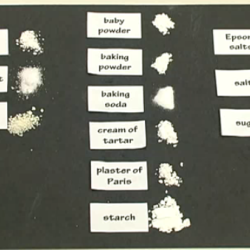Source Institutions
Source Institutions
Add to list Go to activity
Activity link broken? See if it's at the internet archive

In this experiment, learners will conduct chemical and physical tests to identify mystery substances. This experiment is very flexible, allowing educators to determine the number of unknowns to analyze and tests to conduct, as well as the depth of inquiry based on the time they have at their disposal. The activity is a simplified version of "qualitative analysis," a technique used by scientists to identify unknown substances using concepts such as conductivity and solubility. Background questions and explanations are included, as is an extension game.
- 10 to 30 minutes
- 45 to 60 minutes
- $5 - $10 per group of students
- Ages 8 - 14
- Activity, Experiment/Lab Activity, Lesson/Lesson Plan
- English, Spanish
Quick Guide
Materials List (per group of students)
- corn starch, 1 tablespoon
- granulated sugar, 1 tablespoon
- baking powder, 1 tablespoon
- cream of tartar, 1 tablespoon
- baking soda, 1 tablespoon
- table salt, 1 tablespoon
- laundry detergent (must contain sodium carbonate), 1 tablespoon
- Epsom salts, 1 tablespoon
- dry milk powder, 1 tablespoon
- baby powder, 1 tablespoon
- plaster of Paris, 1 tablespoon
- Alka-Seltzer tablets, 1 tablespoon
- ice cube trays (to distribute powders)
- small plastic cups (for mixing)
- plastic spoons (for powders)
- plastic spoon (for mixing)
- Styrofoam or plastic egg carton, preferably white in color
- pop-top squeeze bottles (e.g. water or sports drink), 6 oz. or larger
- vinegar, 1/4 cup
- tincture of iodine, 2 teaspoons
- red cabbage, 1/4 cup
- water, 2 cups
- toothpicks, 10–12
- magnifying glasses (optional)
- paper towels
Subjects
-
Life Sciences
-
Human Senses and Perception
- Smell
- Vision
-
Human Senses and Perception
-
Physical Sciences
-
Heat and Thermodynamics
- Heat and Temperature
-
Electricity and Magnetism
- Electric Charges and Currents
-
Chemistry
- Chemical Reactions
- Acids and Bases
- Solutions
-
States of Matter
- Solids
- Liquids
- Gases
- Changes of Phase
-
Heat and Thermodynamics
-
The Nature of Science
-
The Scientific Process
- Asking Questions
- Conducting Investigations
- Gathering Data
- Formulating Explanations
-
The Scientific Process
Informal Categories
- Crime Science
- Food and Cooking
Audience
To use this activity, learners need to:
- see
- see color
- read
- smell
- touch
Learning styles supported:
- Involves teamwork and communication skills
- Involves hands-on or lab activities
Other
Foreign language versions of this resource:
Components that are part of this resource:
Includes alignment to state and/or national standards:
Access Rights:
- Free access
By:
- Oregon Museum of Science and Industry
Rights:
- All rights reserved, Oregon Museum of Science and Industry, 2007
Funding Sources:
- National Science Foundation
- Camille and Henry Dreyfus Foundation
